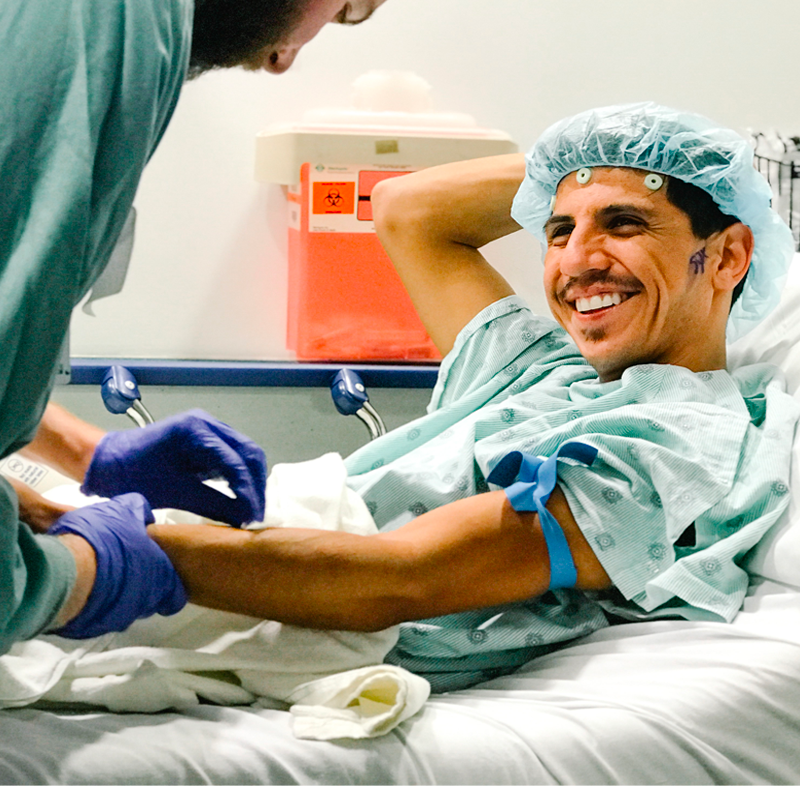In 1774, a British Royal Navy surgeon named James Lind began what is now referred to as the first randomized clinical trial when he divided 12 scurvy-stricken sailors into six groups and administered various treatments. Through meticulous observation and analysis, Lind discovered that the sailors who received citrus fruits experienced significant improvements in their symptoms, thus identifying the cure for scurvy.
Lind’s experiment 250 years ago would revolutionize medical research and pave the way for the evidence-based medicine that now guides scientists. Today, clinical trials provide early access to potentially beneficial treatments, advance science, and play an integral role in developing new and improved treatments for brain tumors.
“Clinical trials are incredibly important for patients and for the field,” said John de Groot, MD, a neuro-oncologist at the University of California, San Francisco, who is part of NBTS’s DNA Damage Response Consortium. “This is the way we’re able to test new therapies and prove whether or not they work or they don’t work.”
According to the National Cancer Institute (NCI), a clinical trial is “a type of research study that tests how well new medical approaches work in people. These studies test new methods of screening, prevention, diagnosis, or treatment of a disease.” A trial can test drugs, devices, and other medical interventions.
NBTS launched the MyTumorID campaign this year to educate and empower patients and care partners to make informed decisions about clinical trials and biomarker testing. Clinical trials may seem daunting at the time of diagnosis due to a lack of understanding about what clinical trials entail, so this MyTumorID blog post will address some of the common misconceptions held by the general public.
Table of Contents
Misconception #1: Clinical trials are a last resort for treatment.
Misconception #2: Clinical trial participants are lab rats.
Misconception #3: Clinical trials are unsafe and too risky.
Misconception #4: Clinical trial participants only get a placebo.
Misconception #5: Participating in a clinical trial will only help others — not me.
Misconception #6: Individuals can only be referred by their doctor to participate in a clinical trial.
Misconception #7: Clinical trials are too expensive.
Misconception #8: Anyone can participate in a clinical trial.
Misconception #9: A patient cannot exit a trial once enrolled.
Misconception #1: Clinical trials are a last resort for treatment.
Many believe clinical trials are only for patients who have exhausted all standard treatment options. However, clinical trials can be beneficial at various stages of treatment, including as a first-line option or alongside standard therapies.
In fact, the National Comprehensive Cancer Network (NCCN) believes the best management of any patient with cancer is a clinical trial. Additionally, clinical trials are an initial treatment after surgery for many brain tumor types, according to NCCN’s 2023 guidelines. NCCN publishes the standards of care for certain types of brain tumors to “help clinicians navigate through the complex management of patients with CNS tumors.”
“I advocated for my husband to get enrolled in a clinical trial following his glioblastoma diagnosis,” said Jessica D., a caregiver and nurse practitioner. “We considered a few options and made an informed decision about which clinical trial made the most sense for us.”
Misconception #2: Clinical trial participants are lab rats.
One worry patients may experience is that they will feel like “lab rats” in a clinical trial. This worry often stems from the fear of being experimented on without full understanding or control over the process. Clinical trials today are conducted with rigorous scientific and ethical standards in place.
Ethical Guidelines
Today, ethical guidelines provide a framework to “protect patient volunteers and to preserve the integrity of the science” according to the National Institutes of Health (NIH). In addition to some of the fundamental codes of ethics that guide the clinical research being done today, including the Nuremberg Code and the World Medical Association’s Declaration of Helsinki, many associations and even health systems have their own code of ethics that must be followed. Examples include but are not limited to:
Scientific Standards
“The structure of the trial is stipulated in something we are aware of called a research protocol,” said Christina Amidei, APN, PhD, Director of Clinical Research, Neurological Surgery at Northwestern University. “It’s a very lengthy document that specifies all the rules that we need to follow and help you follow to conduct the clinical trial. The reason for these very rigid rules is that the rules are important in making sure that the results we gain at the end of the study are actually useful.”
According to Dr. Amidei, patients have rights and responsibilities when they participate in a clinical trial.
- To ask questions and get answers about specific trials
- To receive usual care (the current treatment used in the ordinary course of care) and be presented with options other than research
- Confidentiality
- Access to medical records but no access to research records
- Work with your providers as part of the team — follow clinical trial instructions and attend appointments
- Let them know what you are experiencing — don’t assume it’s expected
In order to enroll in a clinical trial, the patient must sign an informed consent form. This comprehensive paperwork outlines the purpose of the study, potential benefits and risks, and costs associated with the study. Patients and care partners are encouraged to thoroughly review the informed consent form before enrolling in a clinical trial.
While the concern of feeling like a lab rat is understandable, it’s essential to recognize the safeguards in place to protect participants and the potential benefits of participating in clinical trials. Transparency, informed consent, and ethical oversight are fundamental principles that guide the conduct of clinical research, ensuring that participants are treated with dignity and respect.
Misconception #3: Clinical trials are unsafe and too risky.
Patients and care partners may be concerned that participating in a clinical trial involves significant risk, such as unknown side effects or complications. While all medical interventions carry some level of risk, clinical trials are closely monitored for safety, and participants receive regular check-ups and medical attention.
“Another reason some people participate in clinical trials is that they actually get a closer observation both of their clinical status and overall clinical care,” Dr. Amidei said. “Some individuals like that attention and immediate problem-solving that’s offered in this situation.”
Before enrolling in the clinical trial, patients should review the informed consent form, which has a section where the risks are spelled out. They are usually, but not always, separated into sections that indicate which risks are the most likely (expected), risks that are less likely (unexpected), and risks that are rare or uncommon.
“[The uncommon ones] tend to be the serious ones you need to pay attention to,” Dr. Amidei said. “You can always ask questions for more detail from the provider about what those risks mean specifically to you. For example, if you have a seizure history, and the risk is seizure then you might need to know if the risk is higher for you because you have a seizure history already.”
Some of the risks can be difficult to distinguish from the effects of the disease itself or the effect of the treatment. It’s important that patients keep in close communication with their provider about what they’re experiencing and don’t assume that those are expected because they’re listed in the consent. My STORI, a symptom management app from NCI Connect, can help patients document their experiences to communicate with their provider. Patients are encouraged to work with their provider when on a clinical trial to make sure everyone understands what they’re experiencing and what can be done about it.
“I also remind people when they’re reading their informed consent that just because all of those risks are stipulated in that consent, it doesn’t necessarily mean that you’re going to experience all of the side effects or any of the side effects,” Dr. Amidei shared. “Everyone is an individual, and that’s one of the reasons why we closely observe you whenever you’re on a clinical trial to see how you’re tolerating things and how you’re experiencing and responding to treatment. Because of the risks, sometimes we do additional blood tests or more frequent MRIs than you might be used to or more frequent visits to the provider, especially when something is in an early phase or the first cycle of treatment.”
Misconception #4: Clinical trial participants only get a placebo.
For most clinical trials researching potential new brain tumor treatments, patients on the control arm of the trial will receive either standard of care or another comparator treatment. It is rare, though sometimes the case in tumor types that lack a standard of care, that patients in the control group receive only a placebo.
“Classically, people think of a sugar pill as a placebo,” Dr. Amidei said. “It’s something added that we think has no therapeutic effect, and it really helps us determine if the response that we’re seeing in individuals is real due to the therapy or treatment that’s being delivered in the clinical study or if it’s due to something else.”
Prior to enrollment in the clinical trial, researchers must inform potential participants that a placebo will be used in the clinical trial and that they may receive the placebo instead of the treatment under evaluation.
Most of the time, patients randomly assigned to a control arm will still receive the standard of care. In most cancer trials, the aim is to compare the new investigational drug or device against the standard of care.
“It’s important to understand that even on a placebo-controlled study, you should be receiving some treatment, and that treatment should be at least as good as what is currently the standard of care,” Dr. Amidei explained. “The reason that placebo studies are necessary is we really want to know if the effect that we’re seeing is due to the addition of that therapy.”
Misconception #5: Participating in a clinical trial will only help others — not me.
While the primary goal of clinical trials is to advance medical knowledge and improve future treatment options, participants may also experience direct benefits. Many clinical trials test new therapies or interventions that have the potential to be more effective or have fewer side effects than standard treatments. By participating in a trial, patients may gain access to these promising, cutting-edge treatments before they are widely available.
“We’ve kind of exhausted the treatment options that exist and none of them are really targeted at his tumor type anyway,” said Liz P., whose husband has anaplastic ependymoma. “So knowing that, I think clinical trials are our best option right now. The things that we’re doing are not ideal, so we need some better treatment options. I think the way we find them is through clinical trials.”
Additionally, clinical trial participants typically receive close monitoring and care throughout the study period. This monitoring may include regular check-ups, imaging tests, and other assessments to monitor the progression of the disease and evaluate the effects of the treatment. The close attention from health care providers can lead to early detection of any issues and prompt intervention, potentially improving outcomes for participants.
Sometimes participation in a clinical trial may help patients learn more about their tumor, which could open up other opportunities down the road.
“Julio tried to enroll in a trial for CAR T-cell therapy,” Liz said. “Because they were targeting a protein that isn’t commonly tested for, they had to run more pathology on his tumor tissue. They did the testing to see if he had enough of the protein. He did have some of the protein they were targeting, but he didn’t have enough, so he wasn’t able to enroll in that trial. The thing is, if he had enrolled in the trial without having that testing, we would’ve thought, ‘Oh, this just doesn’t work.’ The reality is that they were targeting something, and he didn’t have enough of it for it to be effective.”
Misconception #6: Individuals can only be referred by their doctor to participate in a clinical trial.
While doctors can certainly provide valuable information and guidance regarding clinical trials, patients with brain tumors can also explore clinical trial options on their own.
“You should ask about clinical trials at every visit with your providers,” Dr. Amidei said. “Ask if you’re eligible for anything. Ask if you should be looking for clinical trials. Ask your providers for clarification and direction. Don’t wait for someone to offer a trial to you. We very much encourage early involvement in learning about clinical trials along the way.”
More than 60% of patients in a recent community survey reported that their health care providers never mentioned clinical trials as options for their treatment. Yet according to a journal article in Neuro-Oncology, “In general, when cancer patients are eligible and offered a clinical trial, more than 50% of patients enroll.”
NBTS’s Clinical Trial Finder offers patients, caregivers, and their loved ones a quick way to search for a local trial treatment for one’s specific tumor type.
“If you have friends or family who want to be helpful to you, ask them to participate in looking for clinical trials out there for you,” said Dr. Amidei.
Patients and care partners are encouraged to actively explore clinical trial options on their own and take an active role in their decision-making. It’s also beneficial to ask about possible trials available outside of the center where they are being treated, as a provider may only be knowledgeable about the clinical trials at their center. A patient may qualify for a clinical trial available at another treatment center.
“As much as we love our medical teams, they have a lot of patients, and I like to tell them I have one patient,” Liz said. “So whatever we can do to help participate in Julio’s care, it’s valuable, and it also gives us a little bit of control over something that we have so little control over.”
Misconception #7: Clinical trials are too expensive.
Clinical trials are often perceived as financially burdensome for patients and their families, which can lead to apprehension and reluctance to explore clinical trial opportunities.
Patients do not pay a fee to participate in a clinical trial, but there can be patient expenses after enrollment.
Clinical Trial Costs
Typically in a clinical trial, patients are expected to pay for health care costs that would be done regardless of whether the patient is in a trial or not. These costs would be billed to the patient’s health insurance, with the patient responsible for any co-pays and deductibles. Patient care costs can include doctor visits, imaging, and standard cancer treatments.
“In the United States, commercial insurance plans are required to pay for routine care that is given within a clinical trial with some rare exceptions,” Dr. Amidei explained. “However, some insurance companies will still try to deny coverage for any care provided while on a clinical trial. Medicare is much improved. We do require clinical trials nowadays to have a Medicare coverage determination before we open up the clinical trial so we know that Medicare will support that clinical trial.”
Routine medical costs associated with a clinical trial are covered under Marketplace plans. NBTS encourages patients and caregivers to check with their insurance companies about cost coverage.
If a patient has been denied coverage, they have the right to file an appeal with their insurance provider.
Costs that are unique to the clinical trial are considered research costs. These expenses can include the drug or device being studied, extra doctor visits, and additional lab tests or imaging needed purely for the trial. The clinical trial’s sponsor usually, but not always, pays for these research expenses, as these costs aren’t often covered by health insurance.
“Most importantly, do not assume that everything on the trial that happens is covered by the trial because more often than not some will be billed to your insurance,” Dr. Amidei said.
Other potential costs to consider are travel expenses, particularly if the trial is far from where the patient lives, that are not typically covered by the research study. A patient may need transportation (e.g., flights, gas, parking, etc.) and/or lodging to participate in a trial away from home.
“We actually had two very different experiences when it comes to the cost for clinical trials,” Liz said. “At the National Institutes of Health, they actually helped us cover the transportation expenses as well as a stipend for hotel costs. That was super helpful. When Julio enrolled in the trial that was in California, no travel expenses or lodging were covered. And so we were left to deal with that on our own. Thankfully, we had close friends in the area that we were able to stay with a lot of the time, but we also discovered that there are local and national organizations that can help you with lodging and transportation expenses.”
Talk About Costs Before Enrolling
Costs vary by study, so it’s important to speak with the clinical trial research team to understand which costs would be covered by the study itself and which expenses would be billed to the patient’s health insurance. This discussion will give patients and care partners a better understanding of potential out-of-pocket expenses.
“I would encourage you to talk with your provider if you are concerned about additional costs attributed to a trial that you don’t feel comfortable in taking on,” Dr. Amidei said. “Don’t let that be the reason for you to not be able to be involved in the study. You can ask for consideration of additional support, possibly from another fund not related to the research.”
It’s also helpful to ask whether any visits can be done using telehealth should the study be far from home.
“Some trials do offer the opportunity to have some travel expenses covered for you and a caregiver, so I would ask that upfront,” Dr. Amidei said. “I wouldn’t necessarily eliminate a study because it’s far away or it requires you to travel until you know more about it and see if it might be workable for you.”










